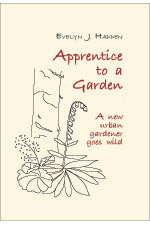| Make your woodland garden a well-loved and well-used part of your landscape. |
| ABOUT US START IDEAS DO LESS USEFUL PLANTS PROJECTS VIEWS RESOURCES TOPICS |
|
|
|||
Including certain design elements can make your woodland more valuable to humans and wildlife. Landmarks or distinguishable features soothe unconscious fears of getting lost; human-built elements promise comfort and safety; pleasant sensory experiences relax and refresh; food and cover entice wildlife; and structural elements make the woodland interesting year-round. Consider which of the following features might enhance your woodland. Feature #1: A Path Paths are essential to experiencing a woodland. They help keep feet dry, guard people from brushing against wet or prickly vegetation, and prevent visitors from getting lost. Equally important, paths minimize human impact on what can be a fragile environment. Woodland soils are often deep and spongy, but stepping on them can compact them and press out the air, making it harder for roots to penetrate and threatening plants' health. Also, plants of the forest floor often appear aboveground for only a season, and treading on them can damage emerging stems that are not yet visible. Paths can be made from stepping stone, pine needles, shredded or chipped wood, packed dirt, sawdust, mat-forming plants, gravel, sand, crushed sea shells, old carpet, and many other materials. When choosing your path material, consider the design statement you want to make as well as visibility, fragrance, ease of installation and maintenance, cost, and longevity. Consider the kind of journey your path will create:For more information on how to design a path through a large planted area, see Design A Stroll Garden. Two books you might find useful are Gordon Hayward's Garden Paths Feature #2: A Clearing People may enjoy exploring your woodland via paths, but if you want them to linger, you need to provide a clearing or other open area. Close vegetation prompts an instinctive alertness in people. A clearing provides greater visibility that invites them to pause, look around, and relax. A clearing allows sunshine into the woodland floor, creating habitat for a greater variety of plants than will grow in the shady regions. Siting grasses and flowering plants across the floor and around the edges of your clearing will attract insects and butterflies, which in turn will attract birds. Feature #3: A Tree Circle More dramatic and less natural-looking than a clearing, a tree circle can be used similarly to create a safe relaxing area and attract wildlife. As a design feature, it can lend magical overtones to your woodland by evoking associations like faery rings and stone circles. Though some trees grow naturally in a circle, the formation is unusual enough to prompt visitors to wonder if it's natural or created, which tinges the place with mystery. A tree circle (and a clearing) can be an exciting gathering spot for people. You might include a fire pit or stone table at the center, surrounded by log or stone benches. Feature #4: A Grove A grove is a cluster of several individual trees of the same kind. It makes a good landmark, and hence adds interest, because most of the woodland will likely be a mix of different tree species. It can also highlight the subtle beauty of a particular species by multiplying the visual impact of one tree's flowers, fruit, or fall color. If you've ever seen a grove of sugar maples in autumn or a springtime slope blanketed in flowering cherries, you know what I mean. A series of slightly overlapping groves in asymmetric shapes, each of a different species of tree, could provide the basis for an entire woodland. This design pattern would make it easier to site trees properly in the landscape and would look natural for many trees that tend to grow in clusters. Plant as you would drifts of perennials or bulbs, with individual trees closer together in the center of the drift and trailing off toward its edges. For more design ideas using clearings, tree circles, and groves, check out Julie Messervy's The Inward Garden: Creating a Place of Beauty and Meaning Feature #5: A Natural Water Feature If you are lucky enough to have a natural stream, pond, or wetland on your property, you'll probably want to walk the fine line between making it accessible to humans and retaining its attraction to local wildlife. Build (or preserve) a buffer of natural, unmowed vegetation around your existing water elements. Mowing up to the shoreline of a pond will attract large groups of ducks and geese and deter local water birds that nest and seek shelter in the typical tall grass and reeds at the water's edge. A buffer of natural vegetation will also protect the water by filtering out pollutants such as lawn chemicals, oils from asphalt, or lime from cement that are carried into the water by runoff. Read more about shoreline landscaping. For practical advice and ideas on how to landscape near water features, try Carrol Henderson's book Lakescaping for Wildlife & Water Quality Feature #6: An Artificial Water Feature If you plan to build a water feature and want it to look natural, consider your site conditions carefully. For instance, you could build a realistic pond or spring in a smaller lot, even in an urban area, but a stream or waterfall is less likely to look natural there unless it's sited cleverly. Consider also how water typically occurs in landscapes with vegetation similar to your woodland. You may want to consult field guides or visit natural areas for clues. You may run into practical limitations when building a water feature. For instance, running water will require electricity to power a pump, so you may need to site it near a building. Water is essential for wildlife and will increase the number of species who visit and live in your woodland. This provides a great opportunity for humans to observe animals. You can encourage this activity by providing a dry path and seating areas with good views of the water. Remind your children, their visiting friends, and neighbor kids about water safety, since water attracts children as well as wildlife. There are many good books about building water features. James Allison's Water in the Garden addresses many types of water features and includes copious glossy color photos suitable for winter browsing. Feature #7: A Dry Water Feature If you like the look of water but don't have the time, money, or interest to build and maintain an artificial water feature, try adding a dry water feature (rocks and/or gravel arranged to suggest a water feature) to your woodland. Consider these possible designs, or think up your own:Your dry water feature can double as a drainage channel or catch basin for runoff. This is a nice option for areas prone to heavy rains or near steep slopes that produce heavy runoff. I've added a hidden drainage channel under a path to carry water away from a skinny, damp urban side yard; see the "Skeleton Rising" chapter of Apprentice to a Garden. In a deciduous woodland, autumn leaves will fall on your dry water feature. You can decide to let them build up, exert more effort to clean them off the rocks once or twice a year, or periodically add gravel to refresh your dry water feature. You can find inspiring photos of dry water features in any book on Japanese Gardens, or visit the Portland Japanese Garden in Oregon for an inspiring example. Feature #8: A Sculpture Several successful sculpture gardens inhabit wooded settings, with objects placed at intervals along a meandering path through the woods. There's a woodland walk at the Pratt Museum in Homer, Alaska, that's dotted with sculptures; some confront you on rounding a corner, others entice you down a straight section of path or appear through a break in the foliage. They're made of old ladders, painted chairs, metal, plastic, pottery, and more. An outdoor sculpture doesn't need to be either pricey or purchased. It can be made from found objects like cement pipes, wire clothes hangers, or driftwood. You can make surprisingly evocative sculptures from a few unassuming raw materials, like the Japanese lantern my neighbors built from a few stacked rocks. A simple stack of rocks (called a cairn) can invite contemplation. Even a boulder is sculptural, and the larger it is, the more dramatic a feature it will be, whether set apart as a curiosity or half-buried among the plantings to look more natural. As this selection demonstrates, a woodland landscape offers the chance to use (and combine) many intriguing design features. The more complex you make your woodland, the more surprises it will hold, and the more it will fascinate you and your guests year-round. |
Other LessLawn articles on how to design, build, and maintain a woodland:
     |
||
|
Thanks for visiting http://www.LessLawn.com! All site contents © 2001-2013 Evelyn J. Hadden, except where noted. All rights reserved. |